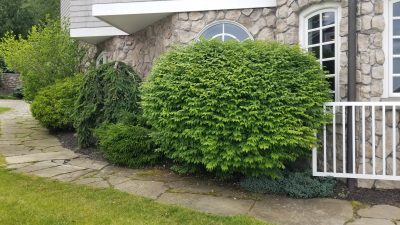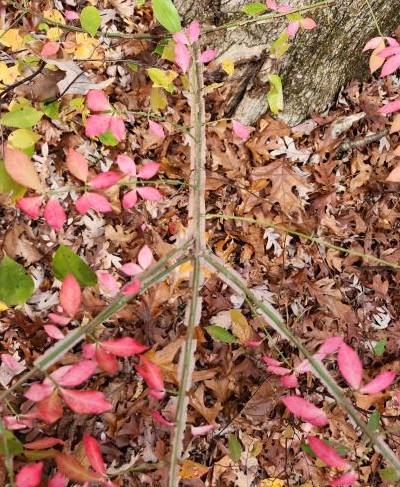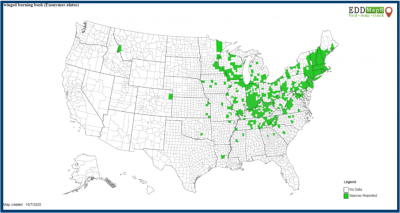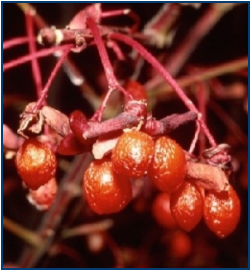Euonymus alatus
By Victoria Wallace and Alyssa Siegel-Miles, UConn Extension
Identifying Features
- OVERVIEW: Fast growing, deciduous, multi-stemmed, woody shrub. Height 5-15 ft. tall. A popular ornamental known for its bright red fall color, it is still commonly planted along interstate highways, as hedges, and in foundation plantings. In woodlands, winged euonymus forms dense thickets, creating a heavy shade that blocks light to native vegetation.
- LEAVES: Opposite, simple, elliptical (football-shaped); 1-2 inches long. Dark green foliage with finely serrated margins turns vibrant red in autumn. Fall color is more pinkish than red in heavy shade.
- STEMS: Green stems with prominent raised, corky wings. Wings may follow the stem lengthwise or be slightly whorled around the stem. Stems become more heavily winged as they grow older. Some “escaped” cultivars lack wings.
- FLOWERS: Small, in groups of three, and yellowish-green; not showy. Appear in late spring.
- FRUIT: Showy cluster of bright red capsules - typically four to a cluster. Fruit pod splits open to expose orange arils with four red-orange seeds inside. Fruit ripens in fall and persists into winter. Fruit is borne on younger stems.
- REPRODUCTION/SPREAD: Reproduces abundantly by seed. Fruit is eaten and spread by birds. Can also spread locally through vegetative reproduction.



Habitat
Adaptable to various environmental and soil conditions. Grows in full sun to full shade. Prefers consistent moisture. Spreads easily from cultivated environments into old fields, open woodlands, and mature second growth forests, replacing native shrubs and displacing native habitat. Thrives in forest interiors where many other invasive shrubs cannot compete in the dense shade.
Control
Do not plant Euonymus alatus as an ornamental! Consider removing any existing burning bush plants used as ornamentals in the landscape. Once an area has been cleared of burning bush, replant with native species to sup-press resprouting and regrowth.
MECHANICAL:
- Sprouts and saplings, up to two feet tall, can be easily hand-pulled, especially when the soil is moist.
- Dig out larger shrubs with a spading fork or pull with a weed wrench. Remove the majority of the root system to prevent regrowth.
- The shrub can be repeatedly cut to the ground. Re-sprouts must be controlled. Mowing with heavy-duty rotary blades (brush hog) or a flail cutter is an option to remove the shrub canopy, but can only be successful with follow up stem treatment (either continued cutting or chemical).
CHEMICAL: Follow label instructions for all applications.
- Burning bush leafs out earlier in the season (late March-April) and drops foliage later than many other species, allowing a longer window for successful herbicide treatments.
- A systemic herbicide, such as glyphosate, can be used as a foliar spray (most effective in early summer, but can be done from early May into October, before the onset of fall color [PA Extension] or painted on cut stems and stumps (can be done all year, weather permitting).
Distribution
Euonymus alatus has spread aggressively in New England, south to northern Florida and the Gulf Coast. It is also found west to Minnesota, with scattered reports in other western and mid-western states.
Background
Euonymus alatus is native to Northeastern Asia, Japan, and Central China. It was introduced to the U.S. in the mid-1800s as an ornamental plant for use in landscaping. Its ability to invade natural areas was first documented in the 1970s.

Native Alternatives
For excellent fall color: fragrant sumac (Rhus aromatica), highbush blueberry (Vaccinium corymbosum), red twig dogwood (Cornus sericea), silky dogwood (Cornus amomum), Virginia sweetspire (Itea virginica - native from Pennsylvania south to Florida, but not to New England or New York).
For persistent berries: highbush cranberry (Viburnum opulus var. americanum), red chokeberry (Aronia arbutifolia), winterberry (Ilex verticillata).
SOURCES:
- Connecticut Invasive Plants Council. (2018, October). Connecticut Invasive Plant List. https://cipwg.uconn.edu/wp-content/uploads/sites/244/2023/04/CT-Invasive-Plant-List-2018_Scientific-Name.pdf
- National Park Service & U.S. Fish and Wildlife Service. (2010). Winged Burning Bush. In Plant Invaders of Mid-Atlantic Natural Areas, 4th ed. https://www.invasive.org/alien/pubs/midatlantic/eual.htm
- Pennsylvania Department of Conservation and Natural Resources. (n.d.). Invasive Plants in Pennsylvania: Burning Bush. http://elibrary.dcnr.pa.gov/GetDocument?docId=1738753&DocName=BurningBush.pdf
- Templeton, S. Gover, A., Jackson, D., & Wurzbacher, S. (Updated 2020, April 14). Burning Bush. PennState Extension. https://extension.psu.edu/burning-bush
- United States Department of Agriculture, Natural Resources Conservation Service. (n.d.). Euonymus alatus (Thunb.) Siebold. Retrieved April 2021 from https://plants.usda.gov/home/plantProfile?symbol=eual13
Questions? Contact:
Vickie Wallace
UConn Extension
Extension Educator
Sustainable Turf and Landscape
Phone: (860) 885-2826
Email: victoria.wallace@uconn.edu
Web: ipm.uconn.edu/school
UConn Extension is committed to providing equal access and full participation for individuals with disabilities within all our programs and activities. Visit s.uconn.edu/accessibility for more resources. UConn is an equal opportunity program provider and employer.
Funds to support the creation of this document were provided by the Crop Protection and Pest Management Extension Implementation Program [grant no. 2017-70006-27201/project accession no. 1013777] from the USDA National Institute of Food and Agriculture.
©UConn Extension. All rights reserved.
Updated April 2021
  |
